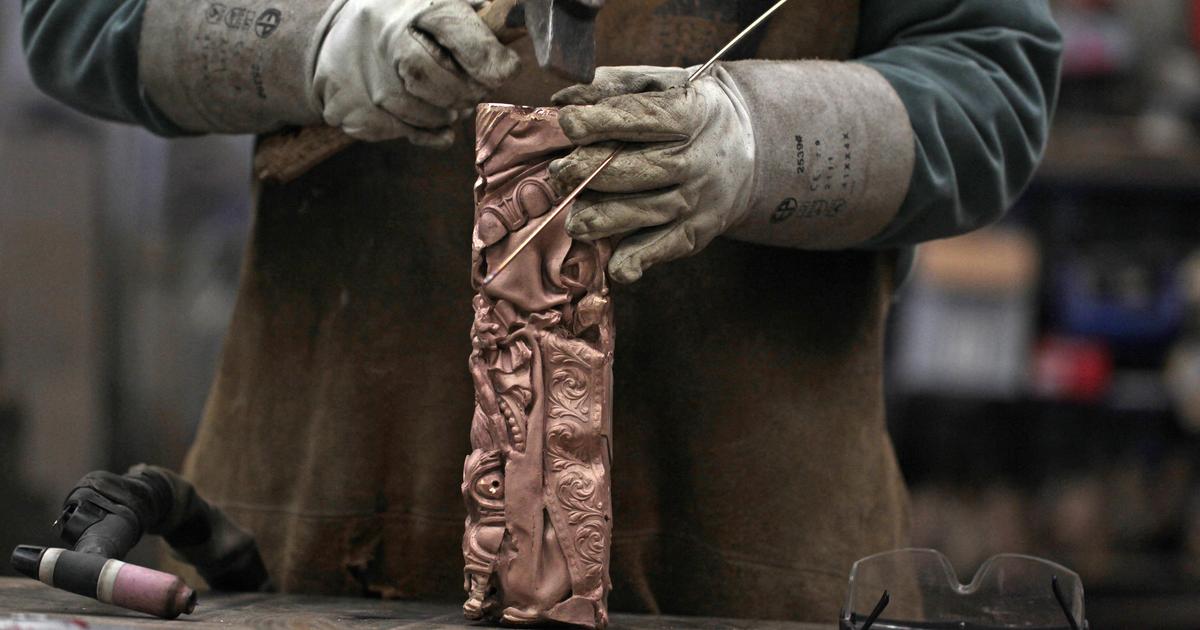Who would have thought that the precious Caesar statuette found its source of inspiration... in a landfill?
In 1960, the modest sculptor César Baldaccini did not have the means to buy bronze to create his works.
He still prefers to go to landfills, where he can find the materials he needs.
But one day, while doing his research in an automobile scrapyard, he discovered the machine that would inspire his creations: a hydraulic press that transformed cars into cubes.
This is how the story of the famous statuette begins.
Why is the trophy called a
“Cesar”
?
The
“Cesar”
trophy actually comes from the first name of the famous eponymous sculptor of the statuettes, renowned for his
“compressions”
.
In the 1950s, several major prizes, such as the Victoires du cinéma français or the Cristal Stars, rewarded achievements in the field of audiovisual and entertainment.
But in 1975, Joseph Cohen, known as Georges Cravenne, journalist and producer, wanted to create in France a ceremony similar to the Oscars, celebrated in the United States.
“The Oscars, I believe, were born in 1927. I was 13 years old then, and since that age I have always been obsessed with the existence of this emblematic character, not of flesh and blood, but of bronze and gilding, whose reputation was worldwide.
Jealousy?
Emulation?”
, he related, as reported on the Académie des César website.
He then decided to create the Academy of Cinema Arts and Techniques, now nicknamed the César Academy, which rewards the most remarkable achievements of French cinema every year in different categories.
The first César cinema ceremony, also called César Night, took place in 1976. Georges Cravenne turned to his friend, the sculptor César Baldaccini, nicknamed César.
“The idea of creating a French equivalent germinated in me, until the day when the name of my friend César, a genius sculptor, imposed itself on me and his sculpture with it.
Oscar, Caesar, five letters which rhymed to such an extent that the birth of the second had become obvious, for the greater good of the promotion of cinema, in Europe at least
,” Georges Cravenne further recounted.
The artist designated to design the trophy at the same time began to become known for his achievements, notably his
“compressions”.
What does the trophy represent?
The original version of the trophy created by César Balsaccini for the first ceremony in 1976 represents a male silhouette surrounded by a film reel.
Faced with the mixed success, he redoubled his efforts to design another trophy for the second edition, a year later.
Nearly 47 years later, it is the representation of this same statuette which is still given to professionals of the seventh art.
The current squeeze is sometimes awkwardly described as a
“crushed log”
.
In reality, the rectangular sculpture was made from a compression of motifs, representing furniture ornamentation.
“I had an encounter with compressed cars.
I find it so beautiful and exciting
,” he confided in the show
“À voix nue”
in 1997, according to Radio France.
How is the trophy made?
But more concretely, how did the sculptor achieve this result, and how are the trophies currently designed before the famous ceremony?
Located in a Normandy village, the Bocquel foundry has been responsible since 1994 for manufacturing the 25 trophies ordered each year by the César Cinema Academy.
“The artist César wanted the Césars to be made by us
,” indicates the workshop to Le
Figaro.
The family business tells us that the manufacturing of the statuettes lasts five months, from the end of September until delivery at the end of February.
All of the trophies require more than 300 hours of work.
The first manufacturing step consists of making casts in elastomer, a material with elastic properties, based on the original model of the Caesar.
Using these, the workshop subsequently produces
“hollow”
wax trophies , specifies the foundry.
The shape obtained is then placed in a cylinder, into which refractory plaster is poured.
After having cooked the cylinders over low heat
“so that the wax melts”
, the cooking is then set to high temperature for more than 48 hours.
In addition, the bronze is cast in fusion into the cylinders where it will occupy the empty space left by the wax which has melted,
“a technique known as lost wax casting”
, explains the workshop.
The next step is the removal of the cylinders:
“the plaster shell around the Caesars is broken
,” explains the family business.
Other phases of the process then consist of chiseling, welding, polishing, cleaning, patinating or even polishing the work.
Nine people with different skills and nearly seven hours of work are needed to make a single trophy.
Certain tasks, such as the work of making the cast iron, as well as the carving, require
“real know-how”
, indicates the workshop to Le
Figaro
.
“Before the
ceremony,
the name of the category is engraved on the trophy
,” continues the foundry.
The Caesars are then packaged and delivered to Paris.
“After the trophy is presented on stage, the winner is taken backstage so that the César is engraved with his name,”
the workshop further reveals.
How much does the trophy cost?
Contrary to what one might think, the reward is not gold, nor covered with a layer of gold.
This creation is actually a hollow block of bronze, polished with red wax to give it its final appearance, the patina.
The statuettes measure 30 cm and weigh approximately 3.7 kg.
“The Caesar has no value, it is a work of art that cannot be bought or sold
,” recalls the Bocquel foundry.
However, even though its value has not been officially disclosed, the price of these trophies is estimated at around 1500 euros.

